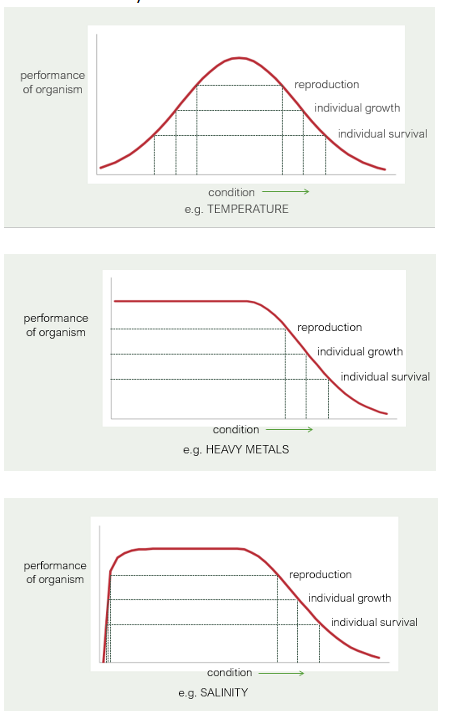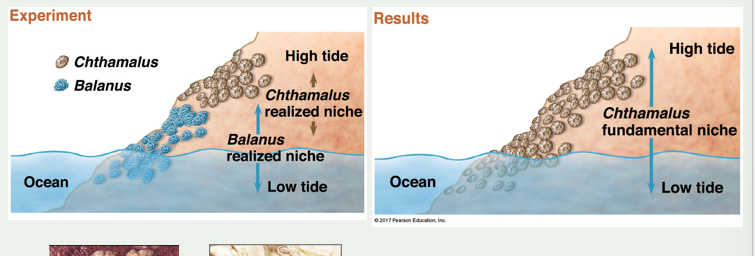Population ecology, adaptation and life histories
1/30
There's no tags or description
Looks like no tags are added yet.
Name | Mastery | Learn | Test | Matching | Spaced |
|---|
No study sessions yet.
31 Terms
what is ecology
The scientific study of the distribution and abundance of organisms, the interactions that determine that distribution and abundance, and the relationships between organisms and the transformation and flux of energy and matter
what does ecology allow the understanding of
Top predators
Invasive species
Sustainably feeding a growing population
Understanding the role of pesticides
How organisms will react to a change in climate
Attempt to mitigate climate change
what is population ecology
explores how biotic and abiotic factors influence the density, distribution, size, and age structure of populations
what is adaptation
The evolutionary process whereby organisms become better suited to their environment over time
what are the 2 types of reasons why species occur where they do
ultimate and proximate
what is ultimate adaptation
Through natural selection organisms become adapted to maximise their fitness in a particular environment
what are the 3 types of fitness within ultimate adaptations
direct, indirect and inclusive
what is direct fitness
The number of offspring an individual produces relative to others in the population
Higher direct fitness if more genes have been passed on by you because you have produced more children
what is indirect fitness
Derives from shared genes with kin other than the individual’s direct offspring
e.g. cousins, nieces, nephews, siblings, etc.
If you assist a family member to raise their child you are indirectly fit as your genes will be passed on through them
what is inclusive fitness
The sum of direct and indirect fitness gains
what is proximate adaptation
here and now
what are the 2 types of biotic factors and their definitions and examples of each
Intraspecific
Interactions within the same species
Competition
Interspecific
Interactions between different species
Competition
Predation
Parasitism
Disease
what are response curves
Abiotic features of the environment affects how well an organism functions (or if it functions at all)

what is an ecological niche
The role and position a species has in its environment; how it meets its needs for food and shelter, how it survives, and how it reproduces. It includes all of its interactions with the biotic and abiotic factors of its environment.
what is an N-dimensional hypervolume
niche
what is the difference between a fundamental niche and a realised niche
Fundamental niche - in the absence of other organisms
Realized niche - in the presence of other organisms
what is a habitat
an objective description of the environment
what is a niche
tells you how a habitat is used
what did the experiment with clams show about their fundmental and realised niches
Balanus is larger and competitively excludes Chthamalus from a large part of its fundamental niche
Balanus's fundamental niche is actually very similar to its realised as it would dry out if it moves further up

what is environmental variability
The environment is continually changing, giving natural selection a “moving target”
what are the different types of environmental variability
Temporal or spatial
Deterministic and predictable or stochastic and unpredictable
what is acclimatization and when does it occur
occurs in a short period and within the organism's lifetime
The process by which an individual organism undergoes physiological adjustment to a change in its environment
Discrete occurrence or part of a periodic cycle e.g. moulting in mammals
what is phenotype plasticity
The ability of an organism to change its phenotype in response to changes in the environment
Generally, more important for immobile than mobile organisms
what kind of changes can it include
Includes all types of environmentally induced changes that may or may not be permanent throughout an individual’s lifespan
Changes include:
Morphological, physiological, behavioural, phenological
what is hibernation
A state of arrested development - which allows organisms to survive periods of adverse conditions and synchronise their life-cycle development with the environmental conditions, to ensure food and mate availability
what are life histories
he role of the changing environment on events affecting growth, survival, development, reproduction
The pattern and duration of key events in an organism’s lifetime which affect the number of offspring produced
The schedule and duration of key events in an organism's lifetime are shaped by natural selection to produce the largest possible number of surviving offspring

what is the difference between iteroparous and semelparous organsims
Iteroparous organisms can breed many times during their life
Semelparous organisms breed once
Some semelparous species are annual - They have a single generation in a year
Others live longer but still only breed once
what are the costs of reproduction
use of finite resources
trade off between growth and reproduction
what was found when the trade off between growth and reproduction was studied in hard beech trees
In trees, growth is visible as rings
The thickness of the ring reflects the investment in growth
Seed traps were placed under individual trees over 33 years
On good years, you see masting (heavy crops of seeds) whilst bad years will see small crops
Both seed fall and growth were variable between years
In mast years the ring size was reduced
Less growth in years they reproduce
They couldn't invest energy into reproduction and growth
This is an observational study

what is the difference between observational and manipulation studies
observational studies shows correlation
Manipulation studies show causation